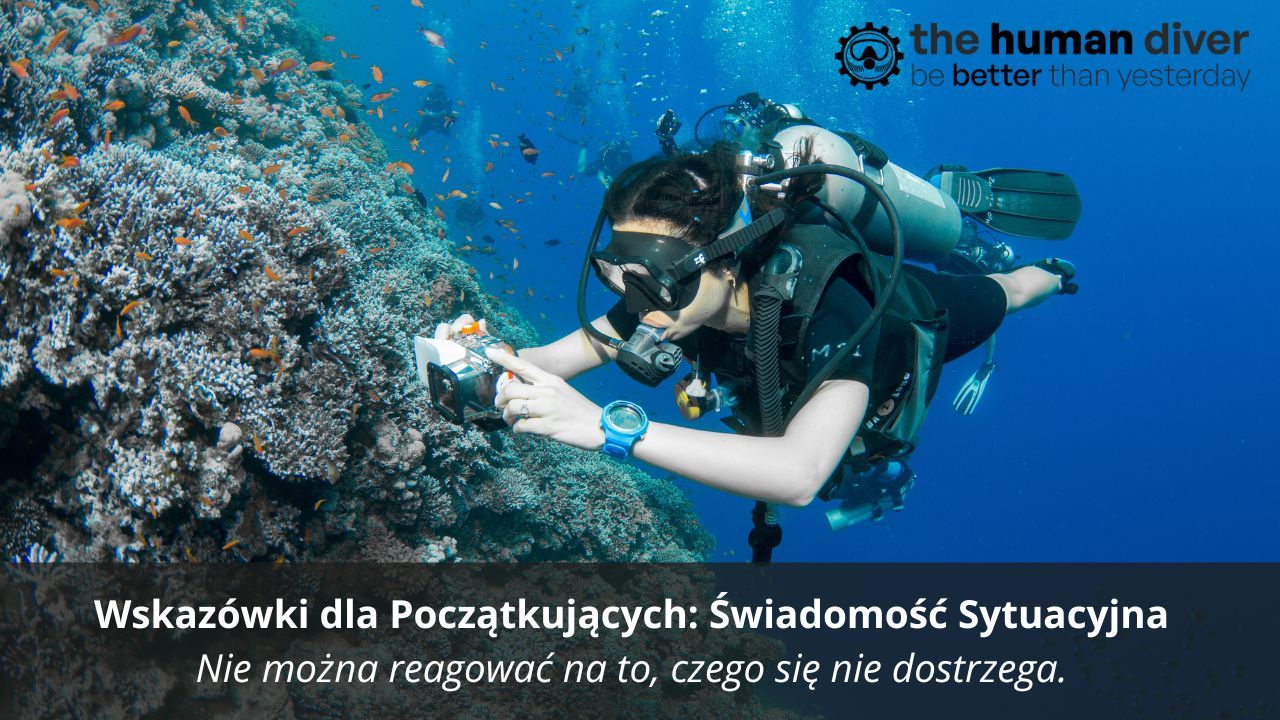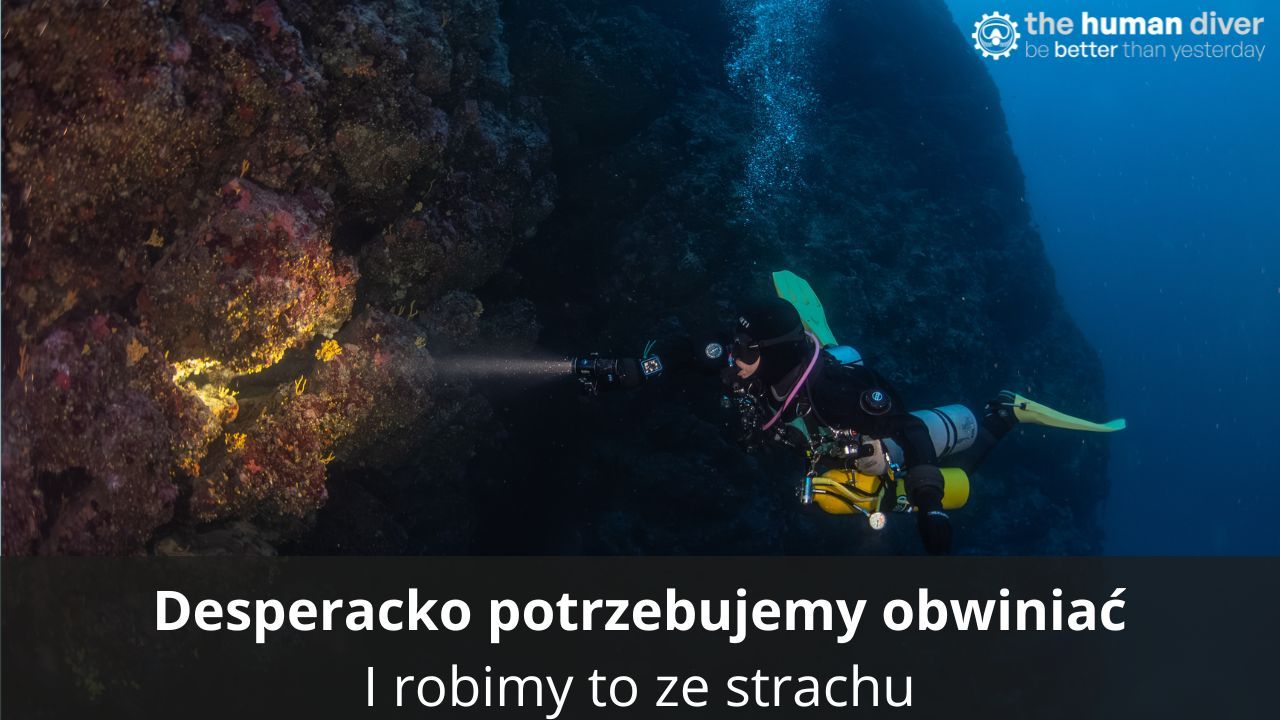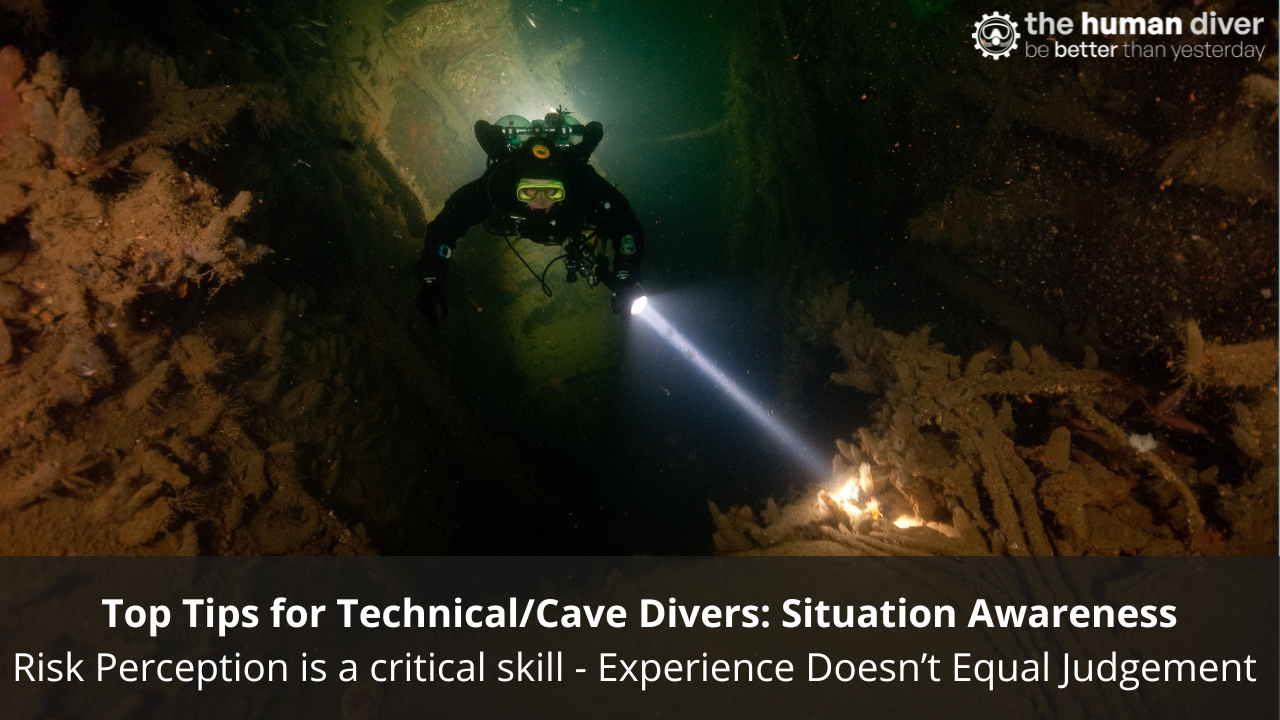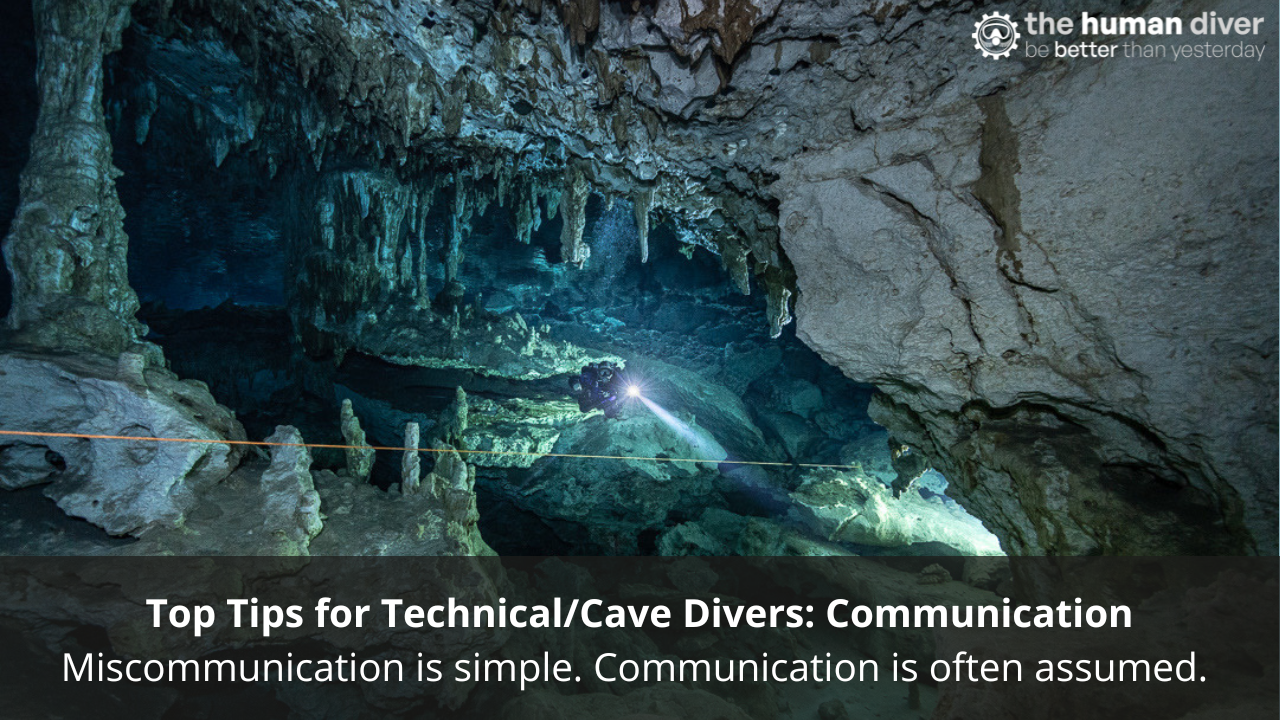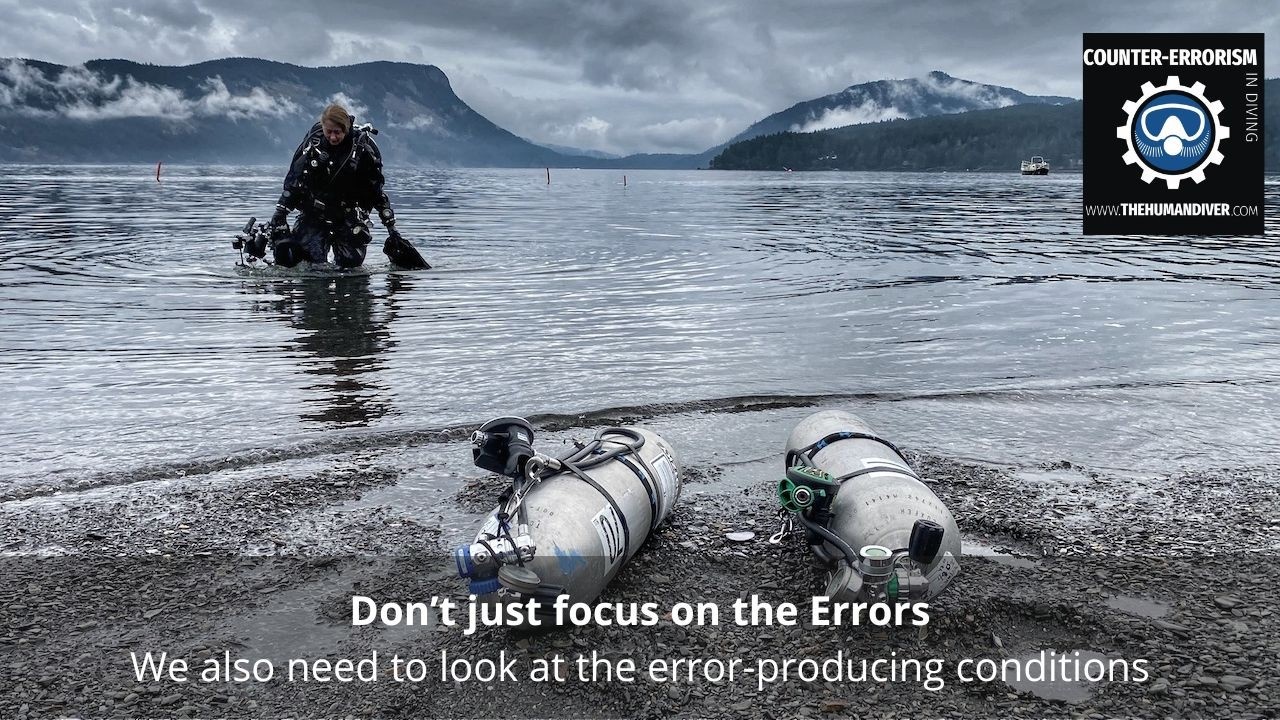
Don’t just focus on the Errors – Look at the Conditions
Aug 21, 2022In last week’s HF in Diving for Dummies blog, the different types of errors were discussed: slips, lapses, mistakes and ‘violations’. These were defined as unintended outcomes from preferred behaviours or something we didn’t expect to happen. Errors happen all the time and yet if they were that much of an issue, you’d think we’d have more diving accidents and incidents than we do. The thing is that an error in itself isn’t an issue, it needs to happen in a specific context where there is a hazard and at least one failed control/mitigation which is there to keep us safe.
For example, in the case of ‘If Only…’, the fact that Brian’s oxygen cylinder on his rebreather was turned off wasn’t an issue. It was only when it was combined with
- Self-induced (time) pressures to get in the water before the others.
- Breathing from the closed-circuit breathing loop and so metabolising the oxygen contained within the loop.
- Operating a CCR with a HUD and buddy light that weren’t easily seen in the bright sunlight.
- Having a higher workload than normal because of the current running.
- A social environment which prevented the team from speaking up.
- An instructor who was busy doing something else and so missed critical information.
that there was a catastrophic outcome. The use of a checklist immediately prior to getting in the water would have trapped the error, a lapse in this case. What about the other factors, the conditions surrounding the event? How do we go about identifying and trapping those?
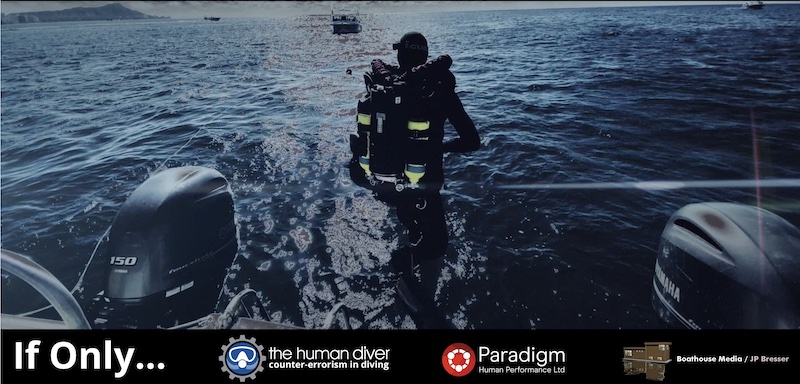
Conditions! Not Outcomes or Errors
First off, we have to educate the diving community about how adverse events occur i.e., a convergence of a hazard, with different types of error, and error-producing conditions which make it more likely that an error will be committed and less likely it will be trapped in time. Things like the social environment that encourages and supports a normalisation of deviance.
The good thing, as with many aspects of bringing Human Factors into diving, researchers, and practitioners from established high-risk environments have already done the hard work! In this case, it was the Institute of Nuclear Power Operations (INPO) that analysed thousands of adverse events to determine the conditions surrounding error-likely situations and their associated error precursors and produced a reference guide.

The WITH or TWIN Model
The rest of this blog will look at the different elements in the TWIN or WITH model and how they apply to diving and how we take them into account while managing risk and uncertainty in our diving and diving instruction. The WITH model is broken down into four areas Work Environment, Individual Capability, Task Demands and Human Nature and these are explained below.
- Work Environment. The general influences of the workplace, organisational, and cultural conditions that affect individual behaviour e.g., distractions, awkward equipment layout, complex procedures, at-risk norms and values, and a risk-seeking or causal attitude toward various hazards.
- Task Demands. The specific mental, physical, and team requirements to perform an activity that may either exceed the capabilities or challenge the limitations of human nature of the individual assigned to the task e.g., excessive workload, reduced time constraints, concurrent actions, unclear roles and responsibilities, and vague standards.
- Individual Capabilities. The unique mental, physical, and emotional characteristics of a particular person that fail to match the demands of the specific task e.g., unfamiliarity with the task, unsafe attitudes, lack of education, lack of knowledge, unpractised skills, inexperience, health and fitness problems, poor communication practices, and low self-esteem.
- Human Nature. The generic traits, dispositions, and limitations that are common to all human beings that may incline them to err under unfavourable conditions e.g., habits, short-term memory, fatigue, stress, complacency/efficiency, and mental shortcuts or heuristics.
Error-precursors exist before the dive starts. Therefore, we have an opportunity to be proactive, looking to reduce or eliminate the pre-cursors and therefore increase the chance of a successful outcome on a dive. This addresses the point Professor James Reason made, “We can’t change the human condition, but we can change the condition in which humans work”.
Unfortunately, the quality of incident data in diving incidents is poor with limited consideration given to the context surrounding the activity and the error-producing conditions that would have been present. As such, there isn’t an opportunity to create a data-driven version of this table which is based on INPO data. Despite this data coming from the nuclear sector, the following explanations and examples should give you an idea of what to look for in your own diving operations to improve performance.
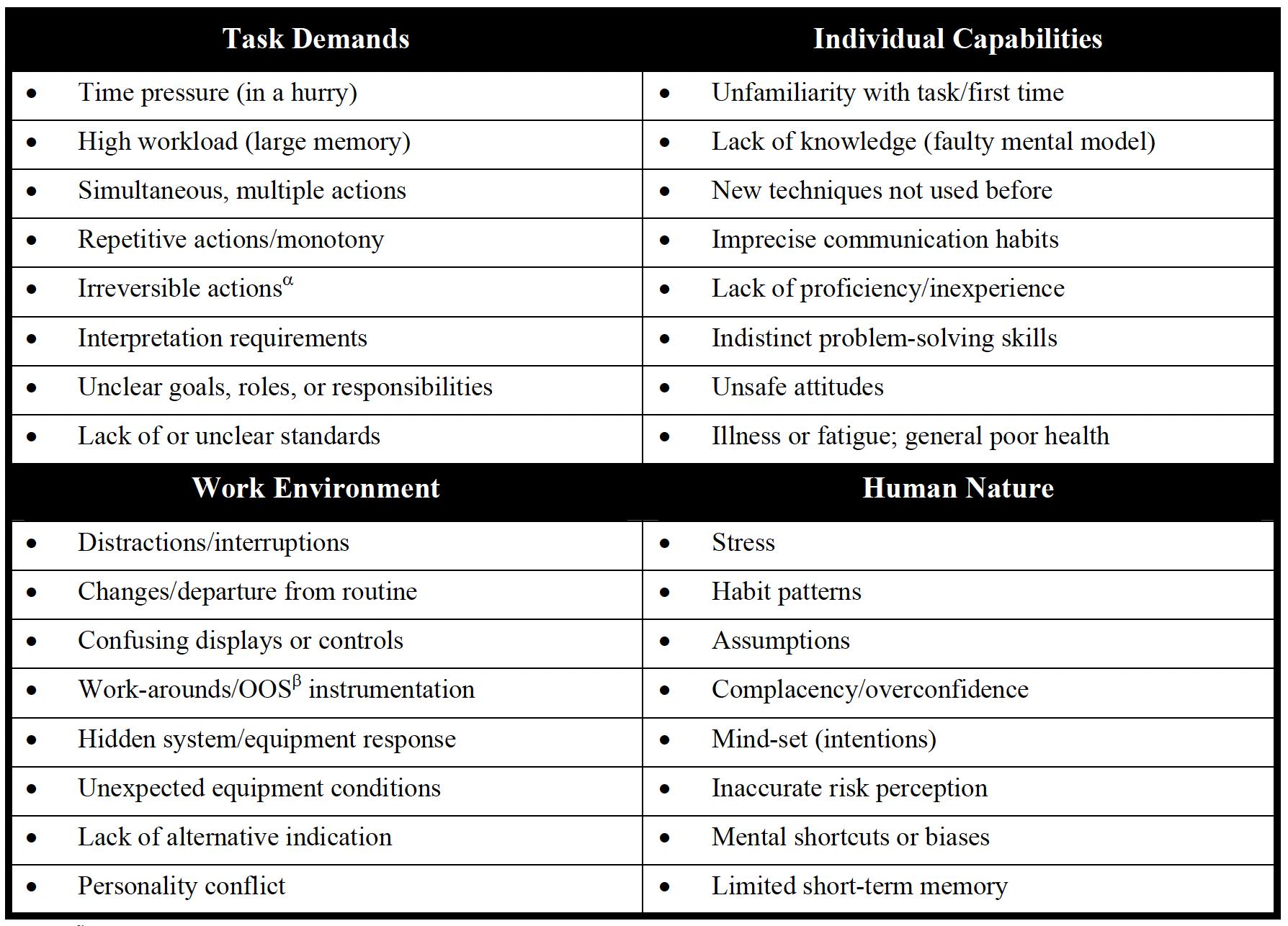
Work Environment
- Distractions/interruptions - Conditions of either the task or work environment that require the individual to stop and restart a task sequence, diverting attention to and from the task at hand e.g., an instructor/dive master preparing dive equipment with clients coming in and asking questions, being on a boat preparing equipment and friends want to chat, or an instructor dealing with email/text queries regarding an upcoming course.
- Changes/departure from routine - Departure from a well-established routine. Unfamiliar or unforeseen task or job-site conditions that potentially disturb an individual's understanding of a task or equipment status e.g., moving from a well-practised rebreather to one which is less used and has a different emergency sequence, or visiting a new site which is 5-10m deeper than the commonly used site, leading to increased gas consumption which isn’t noticed as previous dives were done by ‘rote’.
- Workarounds/out-of-service equipment. Equipment unserviceability or deficiency or programmatic issue that leads to adaptive and non-standard actions to ensure the goals can be completed or a long-term materiel condition problems that place a burden on the individual e.g., rebreather cells which aren’t calibrating correctly, or heating elements on a heated undersuit not working, or 2nd stage regulators which are continually leaking, valves which don’t always open completely due to salt accretion and lack of servicing.
- Unexpected equipment condition. System or equipment status not normally encountered, creating an unfamiliar situation for the individual e.g., a drysuit is fitted with incompatible LP hose feed from the 1st stage, or rebreather displays a warning not seen before and only explained in the manual.
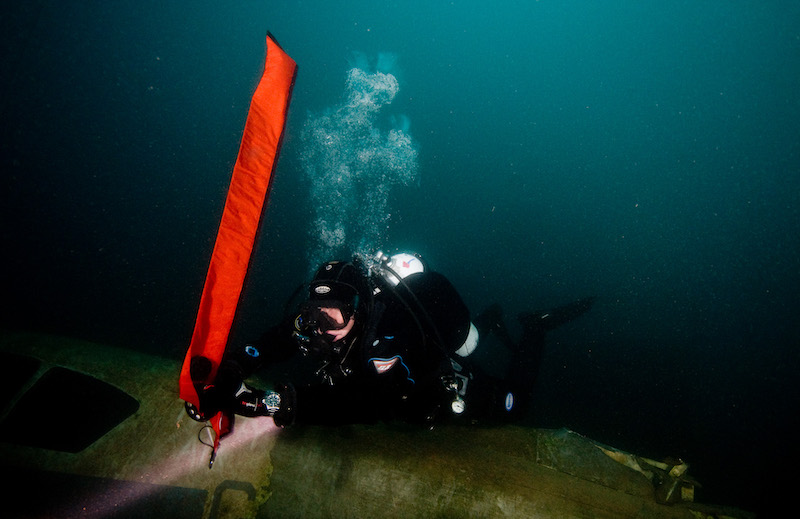
Individual Capabilities
- Unfamiliarity with task/first time they’ve done it. Unawareness of task expectations or performance standards or the first time to perform a task (not performed previously or a significant procedure change) e.g., instructor development has taken place in warm, clear water of an inland dive site, now undertaking a class in the sea, or student on a class has a panicking situation and tries to bolt for the surface – cues to panicking were not recognised as they had had instructors pretending to panic during the instructor development course.
- Lack of knowledge (mental model). Unawareness of fact-based information necessary for successful completion of the task, or lack of practical knowledge about the performance of a task e.g., how to calculate gas consumption at depth to determine how long the divers can stay at the current depth and then complete a successful gas-sharing ascent, or incomplete knowledge about the wreck including internal navigation cues/routing leading to a fatality inside the wreck due to silt out and no line laid.
- Indistinct problem-solving skills. Unsystematic response to unfamiliar situations; inability to develop strategies to resolve problem scenarios without excessive use of trial-and-error or reliance on previously successful solutions. Unable to cope with changing tasks or environmental conditions e.g., a team of divers told to ascend the anchor line but the current is too strong to have everyone in the same place at 6m and an inability to make a decision to leave the shot and drift under a dSMB completing drifting deco or a CESA dive is planned with 4 divers but the DM/AI doesn’t show up and so the instructor leaves the students on the bottom while taking each diver up and down for their CESA drill thereby keeping to the class schedule.

Task Demands
- Time pressure (in a hurry). Urgency or excessive pace necessary to perform action or task, manifested by shortcuts, being in a hurry, and an unwillingness to accept additional work or to help others. No spare time. e.g., multiple classes at a dive centre running at the same time with limited staff, or the skipper announces that the dive site has changed due to reported conditions and so slack is much sooner than planned, or the weather is closing in and the DM forgets to complete the tally before leaving the dive site leaving 2 divers to surface on their own.
- Simultaneous, multiple tasks. Performance of two or more activities, either mentally or physically, that may result in divided attention, mental overload, or reduced vigilance on one or the other task e.g., instructor undertaking final rebreather checks at dive site while also supervising students getting ready and dealing with their queries, skipper without deck crew undertaking a rescue back onto the boat while needing to control the boat along with making radio calls, or cave diving photographer setting up the shot and keeping track of the multiple guidelines in the cave and then exiting on the wrong line due to confusion.
- Lack of or unclear standards. Ambiguity or misunderstanding about acceptable behaviours or results, if unspecified, standards default to those of the front-line worker (instructor, DM or centre manager) e.g., an instructor can take 4 absolute beginners on a dive but needs to retain direct control of those students (2 hands, 4 students) and if one bolts to the surface divers cannot be left on their own, or be on the surface with 50 bar/500 psi – in what size cylinder and how much gas is used in the ascent?

Human Nature
- Stress. Mind's response to the perception of a threat to one's health, safety, self-esteem, or livelihood if the task is not performed to standard, responses may involve anxiety, reduced attention, reduced working memory, poor decision-making, a transition from accurate to fast activity, degree of stress reaction dependent on individual's experience with task e.g., having to deal with multiple students in poor visibility and risk of losing a student, or entered a wreck without a line and the silt percolates from the ceiling quickly reducing visibility to almost zero, or running out of gas at depth and buddy is too far to swim to and gas share leading to a free ascent.
- Assumptions. Assumptions are essential to modern life, but when they are not validated, major issues can occur. They are usually based on the perception of recent experience, provoked by an inaccurate mental model, believed to be fact and stimulated by the inability of the human mind to perceive all facts pertinent to a decision e.g., the visibility/current in the top part of the water column is clear/calm, therefore at depth, it will be clear/calm too, or the sorb in the rebreather has the correct capacity because I only used it for an hour on the last diving, forgetting that I dived it for two hours a couple of days later so it needs to be changed.
- Inaccurate Risk Perception. Personal appraisal of hazards and uncertainty based on either incomplete information or assumptions, unrecognized or inaccurate understanding of a potential consequence or danger. Degree of risk-taking behaviour based on an individual’s perception of the possibility of error and understanding of consequences, more prevalent in males e.g., a novice diver watches a more experienced diver appear to skip checks because they were not overtly completing them and the novice copies, not realising that the more experienced diver was checking things off, or entering a long way into a wreck without a line because the divers have heard of others doing it and not having an issue, or reducing the decompression completed because the divers have seen others do that too.

How to use these ‘conditions’ to improve performance and safety in diving
There are a couple of ways to use the table above and in the linked document. Firstly, you can use it as part of your own risk assessment and pre-dive preparation. Consider whether you’ve got a number of these pre-cursors present. If so, think about what you are going to do to control the likelihood that a slip, lapse or mistake will happen given the different letters in the WITH model. Secondly, given the poor data when it comes to incidents and accidents in diving, think about whether these error-producing conditions were present at the time of the dive. Whatever that person did, it must have made sense for them to do what they did, and these pre-cursors make up part of that story. Remember, you need an error-likely situation (an action, a hazard, and conditions) for an adverse event to occur.
If you are part of an organisation that looks at quality and incidents/near-misses, seriously consider looking at the conditions which appear in these incident/quality reports. In industries which have a relatively high level of safety maturity, investigations look at the ‘extent of causes’ surrounding an event and whether they are present elsewhere in the business unit or company if spread geographically with a view to stopping them from happening elsewhere. A more modern view is to look at the error-producing conditions surrounding an event and whether they can be changed too – going back to Reason’s quote.
Summary
Diving incidents and accidents always occur within a context and have a history behind them. That context is made up of a hazard, some actions, and error-producing conditions. If we want to make a bigger impact on diving safety, rather than focus on the counter-factuals (what the diver didn’t do i.e., could have, should have), look at the conditions surrounding the event to see how it made sense for them to do what they did and see if those conditions can be changed, or at least highlighted prior to the event so divers and instructors are aware that they are more likely to make an error.

Gareth Lock is the owner of The Human Diver, a niche company focused on educating and developing divers, instructors and related teams to be high-performing. If you'd like to deepen your diving experience, consider taking the online introduction course which will change your attitude towards diving because safety is your perception, visit the website.
Want to learn more about this article or have questions? Contact us.




